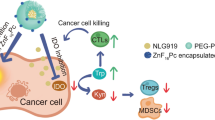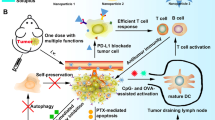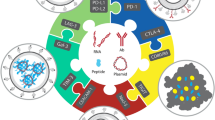Abstract
Immune checkpoint blockade (ICB) has been regarded as one promising approach for tumor immunotherapy. Here, we report a functional nanoplatform based on generation 5 (G5) poly(amidoamine) (PAMAM) dendrimer-entrapped gold nanoparticles (Au DENPs) as a nonviral vector to deliver programmed death-ligand 1 (PD-L1) small interfering RNA (siPD-L1) for subsequent PD-L1 gene silencing-mediated tumor immunotherapy. In this work, G5 dendrimers with amine termini were partially decorated with methoxy polyethylene glycol (mPEG) on their periphery, entrapped Au NPs within their interiors, and were eventually labeled with fluorescamine. The generated functional Au DENPs possess desired dispersibility in water and colloidal stability, satisfactory cytocompatibility after complexation with siPD-L1, and efficient gene delivery performance. Strikingly, the functional Au DENPs enabled the delivery of siPD-L1 to cancer cells to efficiently knock down the PD-L1 protein expression, thus boosting the ICB-based immunotherapy of a xenografted melanoma mouse tumor model with a tumor inhibition efficiency much higher than the PD-L1 antibody. The immune responses were also well demonstrated by downregulation of PD-L1 protein on the tumor cell surface and abundant distribution of CD8+ and CD4+ T cells in the infiltrating tumor tissue and spleen organ. The developed functional dendrimer-based nanoplatform may be promising to boost ICB-based immunotherapy of other tumor types.

摘要
免疫检查点阻断(ICB)被认为是一种有潜力的肿瘤免疫治疗途径. 本文中, 我们报告了基于第5代(G5)聚酰胺-胺树状大分子包 裹金纳米颗粒(Au DENPs)的功能化纳米平台作为非病毒载体传递程序性死亡受体-配体1的小干扰RNA(PD-L1 siRNA, siPD-L1), 用于PD-L1基因沉默介导的肿瘤免疫治疗. 我们在氨基末端的G5树状大分子表面部分修饰甲氧基聚乙二醇, 在其内部空腔包裹金纳米颗粒, 最终标记荧光胺. 制备得到的功能化Au DENPs具有良好的水溶液分散性和胶体稳定性, 与siPD-L1复合后具有良好的细胞相容性和有效的基因传递性能. 通过功能化的Au DENPs将siPD-L1传递至肿瘤细胞可有效沉默PD-L1蛋白的表达, 从而促进基于ICB的异种移植黑色素瘤小鼠肿瘤模型的免疫治疗, 且其肿瘤抑制率远高于PD-L1抗体. 通过肿瘤细胞表面PD-L1蛋白表达的下调以及浸润的肿瘤组织和脾脏中CD8+和CD4+T细胞的大量分布, 免疫响应得到了很好的验证. 该功能化树状大分子纳米平台有望用于基于ICB的免疫疗法治疗其他类型肿瘤.
Similar content being viewed by others
References
Chen DS, Mellman I. Oncology meets immunology: The cancer-immunity cycle. Immunity, 2013, 39: 1–10
Dunn GP, Bruce AT, Ikeda H, et al. Cancer immunoediting: From immunosurveillance to tumor escape. Nat Immunol, 2002, 3: 991–998
Park JJ, Omiya R, Matsumura Y, et al. B7-H1/CD80 interaction is required for the induction and maintenance of peripheral T-cell tolerance. Blood, 2010, 116: 1291–1298
Paterson AM, Brown KE, Keir ME, et al. The programmed death-1 ligand 1:B7-1 pathway restrains diabetogenic effector T cells in vivo. J Immunol, 2011, 187: 1097–1105
Yang J, Riella LV, Chock S, et al. The novel costimulatory programmed death ligand 1/B7.1 pathway is functional in inhibiting alloimmune responses in vivo. J Immunol, 2011, 187: 1113–1119
Francisco LM, Sage PT, Sharpe AH. The PD-1 pathway in tolerance and autoimmunity. Immunol Rev, 2010, 236: 219–242
Freeman GJ, Long AJ, Iwai Y, et al. Engagement of the PD-1 immunoinhibitory receptor by a novel B7 family member leads to negative regulation of lymphocyte activation. J Exp Med, 2000, 192: 1027–1034
Andrews MC, Wargo JA. Cancer evolution during immunotherapy. Cell, 2017, 171: 740–742
Wei SC, Levine JH, Cogdill AP, et al. Distinct cellular mechanisms underlie anti-CTLA-4 and anti-PD-1 checkpoint blockade. Cell, 2017, 170: 1120–1133
Philips GK, Atkins M. Therapeutic uses of anti-PD-1 and anti-PD-L1 antibodies. Int Immunol, 2015, 27: 39–46
Topalian SL, Drake CG, Pardoll DM. Targeting the PD-1/B7-H1 (PD-L1) pathway to activate anti-tumor immunity. Curr Opin Immunol, 2012, 24: 207–212
Sznol M, Chen L. Antagonist antibodies to PD-1 and B7-H1 (PD-L1) in the treatment of advanced human cancer—Response. Clin Cancer Res, 2013, 19: 5542
Topalian SL, Hodi FS, Brahmer JR, et al. Safety, activity, and immune correlates of anti-PD-1 antibody in cancer. N Engl J Med, 2012, 366: 2443–2454
Boutros C, Tarhini A, Routier E, et al. Safety profiles of anti-CTLA-4 and anti-PD-1 antibodies alone and in combination. Nat Rev Clin Oncol, 2016, 13: 473–486
Valsecchi ME. Combined nivolumab and ipilimumab or monotherapy in untreated melanoma. N Engl J Med, 2015, 373: 1270–1271
Wang D, Wang T, Liu J, et al. Acid-activatable versatile micelle-plexes for PD-L1 blockade-enhanced cancer photodynamic immunotherapy. Nano Lett, 2016, 16: 5503–5513
Hobo W, Maas F, Adisty N, et al. siRNA silencing of PD-L1 and PD-L2 on dendritic cells augments expansion and function of minor histocompatibility antigen-specific CD8+ T cells. Blood, 2010, 116: 4501–4511
Hobo W, Novobrantseva TI, Fredrix H, et al. Improving dendritic cell vaccine immunogenicity by silencing PD-1 ligands using siRNA-lipid nanoparticles combined with antigen mRNA electroporation. Cancer Immunol Immunother, 2013, 62: 285–297
Teo PY, Yang C, Whilding LM, et al. Ovarian cancer immunotherapy using PD-L1 siRNA targeted delivery from folic acid-functionalized polyethylenimine: strategies to enhance T cell killing. Adv Healthcare Mater, 2015, 4: 1180–1189
Wu Y, Gu W, Li J, et al. Silencing PD-1 and PD-L1 with nanoparticle-delivered small interfering RNA increases cytotoxicity of tumor-infiltrating lymphocytes. Nanomedicine, 2019, 14: 955–967
Lian S, Xie R, Ye Y, et al. Simultaneous blocking of CD47 and PD-L1 increases innate and adaptive cancer immune responses and cytokine release. EBioMedicine, 2019, 42: 281–295
Clark CA, Gupta HB, Sareddy G, et al. Tumor-intrinsic PD-L1 signals regulate cell growth, pathogenesis, and autophagy in ovarian cancer and melanoma. Cancer Res, 2016, 76: 6964–6974
Guan X, Lin L, Chen J, et al. Efficient PD-L1 gene silence promoted by hyaluronidase for cancer immunotherapy. J Control Release, 2019, 293: 104–112
Li G, Gao Y, Gong C, et al. Dual-blockade immune checkpoint for breast cancer treatment based on a tumor-penetrating peptide assembling nanoparticle. ACS Appl Mater Interfaces, 2019, 11: 39513–39524
Hou W, Wei P, Kong L, et al. Partially PEGylated dendrimer-entrapped gold nanoparticles: A promising nanoplatform for highly efficient DNA and siRNA delivery. J Mater Chem B, 2016, 4: 2933–2943
Shan Y, Luo T, Peng C, et al. Gene delivery using dendrimer-entrapped gold nanoparticles as nonviral vectors. Biomaterials, 2012, 33: 3025–3035
Chen H, Fan Y, Hao X, et al. Adoptive cellular immunotherapy of tumors via effective CpG delivery to dendritic cells using dendrimer-entrapped gold nanoparticles as a gene vector. J Mater Chem B, 2020, 8: 5052–5063
Hou W, Wen S, Guo R, et al. Partially acetylated dendrimer-entrapped gold nanoparticles with reduced cytotoxicity for gene delivery applications. J Nanosci Nanotechnol, 2015, 15: 4094–4105
Xiong Z, Alves CS, Wang J, et al. Zwitterion-functionalized dendrimer-entrapped gold nanoparticles for serum-enhanced gene delivery to inhibit cancer cell metastasis. Acta Biomater, 2019, 99: 320–329
Qiu J, Kong L, Cao X, et al. Dendrimer-entrapped gold nanoparticles modified with β-cyclodextrin for enhanced gene delivery applications. RSC Adv, 2016, 6: 25633–25640
Qiu J, Kong L, Cao X, et al. Enhanced delivery of therapeutic siRNA into glioblastoma cells using dendrimer-entrapped gold nanoparticles conjugated with β-cyclodextrin. Nanomaterials, 2018, 8: 131
Kong L, Alves CS, Hou W, et al. RGD peptide-modified dendrimer-entrapped gold nanoparticles enable highly efficient and specific gene delivery to stem cells. ACS Appl Mater Interfaces, 2015, 7: 4833–4843
Xiao T, Hou W, Cao X, et al. Dendrimer-entrapped gold nanoparticles modified with folic acid for targeted gene delivery applications. Biomater Sci, 2013, 1: 1172–1180
Lin L, Fan Y, Gao F, et al. UTMD-promoted co-delivery of gemcitabine and miR-21 inhibitor by dendrimer-entrapped gold nanoparticles for pancreatic cancer therapy. Theranostics, 2018, 8: 1923–1939
Wei P, Chen J, Hu Y, et al. Dendrimer-stabilized gold nanostars as a multifunctional theranostic nanoplatform for CT imaging, photothermal therapy, and gene silencing of tumors. Adv Healthcare Mater, 2016, 5: 3203–3213
Li J, Shen M, Shi X. Poly(amidoamine) dendrimer-gold nanohybrids in cancer gene therapy: A concise overview. ACS Appl Bio Mater, 2020, 3: 5590–5605
Wang G, Fu L, Walker A, et al. Label-free fluorescent poly(amidoamine) dendrimer for traceable and controlled drug delivery. Biomacromolecules, 2019, 20: 2148–2158
Song C, Xiao Y, Ouyang Z, et al. Efficient co-delivery of microRNA 21 inhibitor and doxorubicin to cancer cells using core-shell tecto dendrimers formed via supramolecular host-guest assembly. J Mater Chem B, 2020, 8: 2768–2774
Zhu J, Zheng L, Wen S, et al. Targeted cancer theranostics using alpha-tocopheryl succinate-conjugated multifunctional dendrimer-entrapped gold nanoparticles. Biomaterials, 2014, 35: 7635–7646
Jeong JO, Jeong SI, Park JS, et al. Development and characterization of heparin-immobilized polycaprolactone nanofibrous scaffolds for tissue engineering using gamma-irradiation. RSC Adv, 2017, 7: 8963–8972
Ritter H, Nieminen M, Karppinen M, et al. A comparative study of the functionalization of mesoporous silica MCM-41 by deposition of 3-aminopropyltrimethoxysilane from toluene and from the vapor phase. Microporous Mesoporous Mater, 2009, 121: 79–83
Conner SD, Schmid SL. Regulated portals of entry into the cell. Nature, 2003, 422: 37–44
Wang C, Ye Y, Hochu GM, et al. Enhanced cancer immunotherapy by microneedle patch-assisted delivery of anti-PD1 antibody. Nano Lett, 2016, 16: 2334–2340
Dikmen HO, Hemmerich M, Lewen A, et al. GM-CSF induces noninflammatory proliferation of microglia and disturbs electrical neuronal network rhythms in situ. J Neuroinflammation, 2020, 17: 235
Acknowledgements
This work was supported by the National Key R&D Program of China (2017YFE0196200), the National Natural Science Foundation of China (81761148028 and 21773026), and the Science and Technology Commission of Shanghai Municipality (19XD1400100, 205207130300, 20DZ2254900 and 19410740200). Shi X also acknowledges the support by FCT-Fundação para a Ciência e a Tecnologia through the CQM Base Fund—UIDB/00674/2020, and Programmatic Fund—UIDP/00674/2020, and by ARDITI-Agência Regional para o Desenvolvimento da Investigação Tecnologia e Inovação, through the project M1420-01-0145-FEDER-000005—Centro de Química da Madeira—CQM+ (Madeira 14–20 Program).
Author information
Authors and Affiliations
Contributions
Author contributions Xue X carried out the experiments including synthesis, characterization, and in vitro and in vivo evaluation of the vector/siPD-L1 polyplexes, and wrote the original draft of the manuscript; Li J and Fan Y carried out part of the material characterization and in vitro evaluation of the materials; Shen M performed part of the data analysis and interpretation. Shi X designed and supervised the whole project and did the final manuscript editing.
Corresponding author
Ethics declarations
Conflict of interest The authors declare no competing financial interest.
Additional information
Xue Xue obtained her BS degree in pharmaceutical engineering from Shanghai University of Engineering Science in 2018. Now she is an MS student of biomedical engineering at Donghua University under the supervision of Prof. Xiang-yang Shi. Her research interests focus on the design of dendrimer-based systems for cancer therapy.
Xiangyang Shi obtained his PhD degree in 1998 from the Chinese Academy of Sciences. From 2002 to 2008, he was appointed as a research fellow, research associate II, research investigator, and research assistant professor at the University of Michigan, Ann Arbor. In September 2008, he joined Donghua University as a full professor. His research interests focus on organic/inorganic hybrid nanoplatforms for sensing, imaging, and theranostic applications, in particular for precision cancer imaging and therapy.
Rights and permissions
About this article
Cite this article
Xue, X., Li, J., Fan, Y. et al. Gene silencing-mediated immune checkpoint blockade for tumor therapy boosted by dendrimer-entrapped gold nanoparticles. Sci. China Mater. 64, 2045–2055 (2021). https://doi.org/10.1007/s40843-020-1591-1
Received:
Accepted:
Published:
Issue Date:
DOI: https://doi.org/10.1007/s40843-020-1591-1




